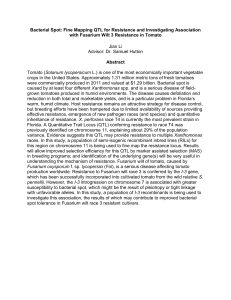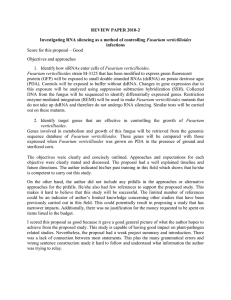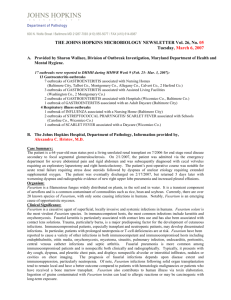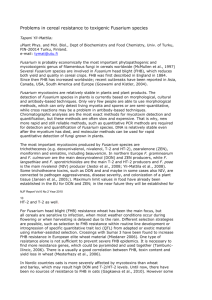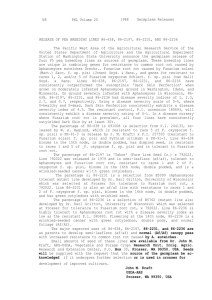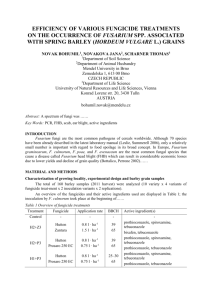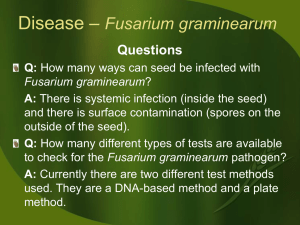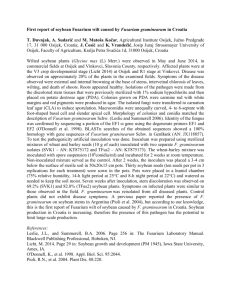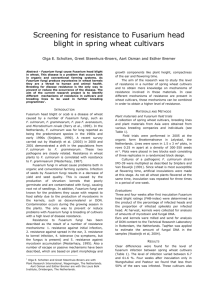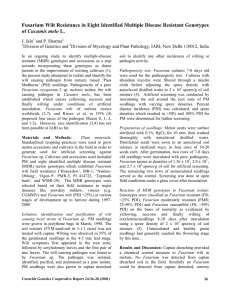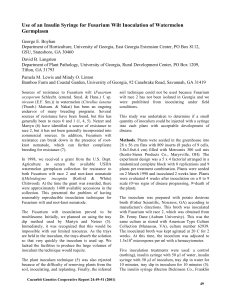No 24: Fusarium - Johns Hopkins Medicine
advertisement
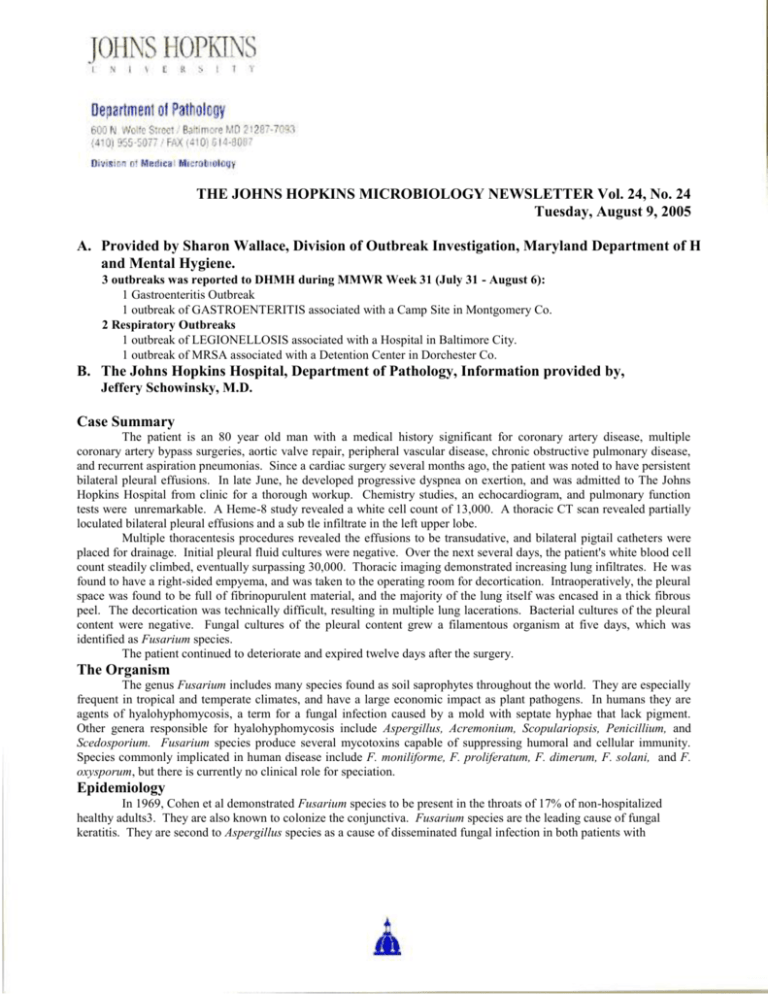
THE JOHNS HOPKINS MICROBIOLOGY NEWSLETTER Vol. 24, No. 24 Tuesday, August 9, 2005 A. Provided by Sharon Wallace, Division of Outbreak Investigation, Maryland Department of Health and Mental Hygiene. 3 outbreaks was reported to DHMH during MMWR Week 31 (July 31 - August 6): 1 Gastroenteritis Outbreak 1 outbreak of GASTROENTERITIS associated with a Camp Site in Montgomery Co. 2 Respiratory Outbreaks 1 outbreak of LEGIONELLOSIS associated with a Hospital in Baltimore City. 1 outbreak of MRSA associated with a Detention Center in Dorchester Co. B. The Johns Hopkins Hospital, Department of Pathology, Information provided by, Jeffery Schowinsky, M.D. Case Summary The patient is an 80 year old man with a medical history significant for coronary artery disease, multiple coronary artery bypass surgeries, aortic valve repair, peripheral vascular disease, chronic obstructive pulmonary disease, and recurrent aspiration pneumonias. Since a cardiac surgery several months ago, the patient was noted to have persistent bilateral pleural effusions. In late June, he developed progressive dyspnea on exertion, and was admitted to The Johns Hopkins Hospital from clinic for a thorough workup. Chemistry studies, an echocardiogram, and pulmonary function tests were unremarkable. A Heme-8 study revealed a white cell count of 13,000. A thoracic CT scan revealed partially loculated bilateral pleural effusions and a sub tle infiltrate in the left upper lobe. Multiple thoracentesis procedures revealed the effusions to be transudative, and bilateral pigtail catheters were placed for drainage. Initial pleural fluid cultures were negative. Over the next several days, the patient's white blood cell count steadily climbed, eventually surpassing 30,000. Thoracic imaging demonstrated increasing lung infiltrates. He was found to have a right-sided empyema, and was taken to the operating room for decortication. Intraoperatively, the pleural space was found to be full of fibrinopurulent material, and the majority of the lung itself was encased in a thick fibrous peel. The decortication was technically difficult, resulting in multiple lung lacerations. Bacterial cultures of the pleural content were negative. Fungal cultures of the pleural content grew a filamentous organism at five days, which was identified as Fusarium species. The patient continued to deteriorate and expired twelve days after the surgery. The Organism The genus Fusarium includes many species found as soil saprophytes throughout the world. They are especially frequent in tropical and temperate climates, and have a large economic impact as plant pathogens. In humans they are agents of hyalohyphomycosis, a term for a fungal infection caused by a mold with septate hyphae that lack pigment. Other genera responsible for hyalohyphomycosis include Aspergillus, Acremonium, Scopulariopsis, Penicillium, and Scedosporium. Fusarium species produce several mycotoxins capable of suppressing humoral and cellular immunity. Species commonly implicated in human disease include F. moniliforme, F. proliferatum, F. dimerum, F. solani, and F. oxysporum, but there is currently no clinical role for speciation. Epidemiology In 1969, Cohen et al demonstrated Fusarium species to be present in the throats of 17% of non-hospitalized healthy adults3. They are also known to colonize the conjunctiva. Fusarium species are the leading cause of fungal keratitis. They are second to Aspergillus species as a cause of disseminated fungal infection in both patients with hematologic malignancy and recipients of bone marrow or stem cell transplant. Boutati et al reported the incidence of fusarial infections over a ten year period to be 1.2% for 750 allogeneic bone marrow transplant recipients, and 0.2% for 1537 autologous bone marrow transplant recipients2. Reservoirs for fusarial infection include plants and hospital water systems. Clinical Manifestations Fusarium keratitis is seen frequently in developing countries, and is the leading cause of fungal keratitis in the United States. Occurrences are usually linked either to implantation of soil or vegetable matter during ocular trauma, or to the use of topical steroids and antibiotics in patients with corneal disease. The keratitis may eventually progress to endophthalmitis. Fusarium is the leading non-dermatophytic agent of onychomycosis, causing 9-44% of such infections. It is seen largely in persons who walk barefoot or in sandals, and differs from dermatophytic onychomycoses in that it often manifests as a white, superficial infection of the nail. In immunocompromised individuals, fusarial onychomycosis may progress to disseminated disease. Fusarium may present as a cutaneous infection. In immunocompetent individuals, the infection is usually localized, and often presents as a nodular lesion with breakdown of overlying skin. In immunocompromised persons, these infections are usually rapidly progressive and resistant to treatment. Disseminated Fusarial infections are seen in patients with hematologic malignancies or severe burns. They frequently present as a persistent fever refractory to antifungals and antibiotics. The skin is involved in 70-90% of cases, the lungs are involved in 70-80% of cases, and the sinuses are involved in 70-80% of cases4. Clinically, disseminated fusariosis mimics disseminated aspergillosis. Features suggestive of fusariosis include skin lesions and positive blood cultures, which are not seen nearly as often in aspegillosis. Laboratory Diagnosis Blood cultures are positive for Fusarium in 40-60% of cases of disseminated disease, but are rarely positive in localized disease. Histologically, Fusarium appears very similar to other agents of hyalohyphomycosis, including Aspergillus, and is usually unable to be identified in this manner. Possible methods for definitive histopathological identification are not currently employed at The Johns Hopkins Hospital, but include fluorescent antibody reagents and in-situ hybridization specific for the different genera causing hyalohyphomycosis. Definitive diagnosis of Fusarium requires culture from a clinical specimen, such as blood, fluid, or tissue. On Sabouraud dextrose agar, Fusarium species will form colonies that are initially white and cottony, but rapidly develop a pink or violet hued center. The periphery of the colony may remain white, or develop a tan or orange hue. Microscopy demonstrates septate hyphae with two types of conidiation. The most classic form consists of branched or unbranched conidiophores with phialides producing sickle- or canoe-shaped macroconidia with 3 to 5 septa (left half of figure). The second form consists of simple conidiophores bearing small, oval 1- or 2-celled conidia singly or in clusters (right half of figure) 6. Treatment and Outcome Disseminated Fusarium infections are usually fatal, both because of the typically poor immune status of the hosts, and because it is resistant to almost all antifungal medications. The white blood cell count is the main determinant of outcome, and colony stimulating factors can be used to fight infections. Recent studies have indicated some success using voriconazole, posaconazole, and amphotericin B1. Echinocandins have not proved effective for fusariosis in vitro1. Solitary cutaneous lesions may be excised. Topical natamycin or amphotericin B ointment is the preferred treatment for keratitis. Onychomycosis is treated with a combination of systemic terbenafine, systemic itraconazole, and nail plate avulsion, followed by topical terbenafine and ciclopirix nail lacquer, but this regimen is curative in only 40% of patients4. REFERENCES: 1. Al Abdely, H.M. Management of rare fungal infections. Current Opin Infect Dis 17(6): 527-32, 2004. 2. Boutati, E.I. et al. Fusarium, a significant emerging pathogen in patients with hematologic malignancy. Blood 90: 999-1008, 1997. 3. Cohen, R.et al. Fungal flora of the normal human small and large intestine. NEJM 280: 638-41, 1969. 4. Dignani, M.C. et al. Human fusariosis. Clin Microbiol Infect 10(S1): 67-75, 2004. 5. Kwon-Chung, K.J. and Bennett, J.E. Medical Mycology. Lea & Febiger, 1992. 6. Larone, D.H. Medically Important Fungi. ASM Press, 2002.
